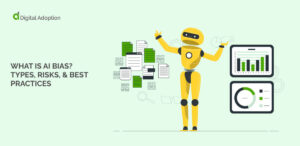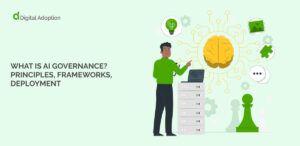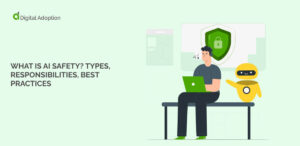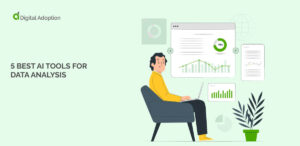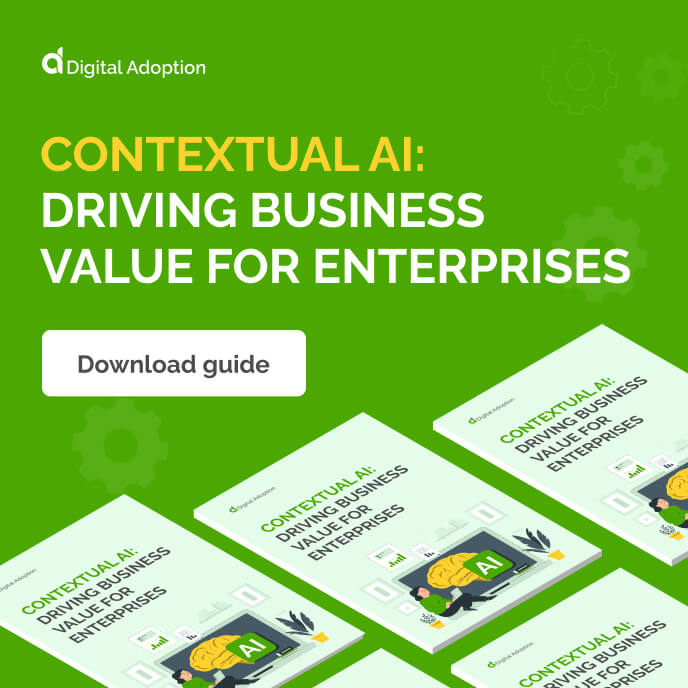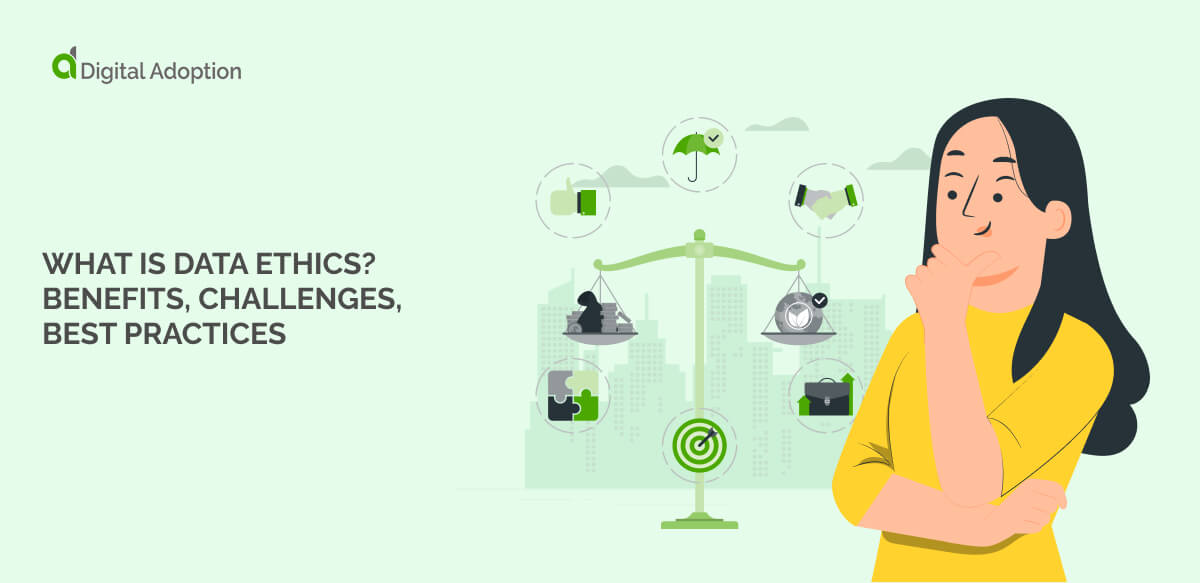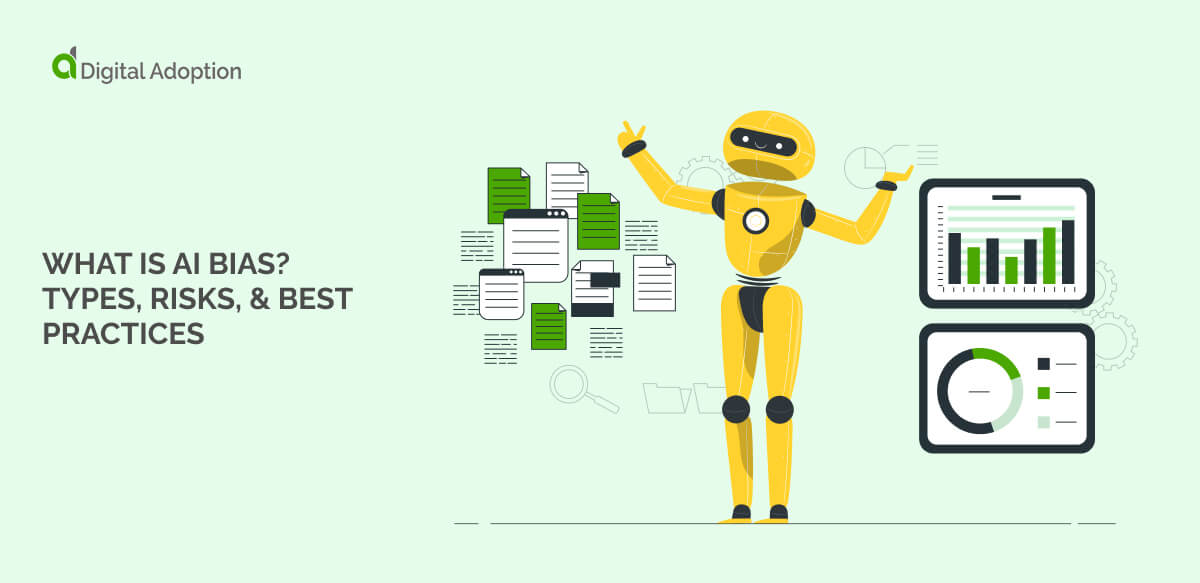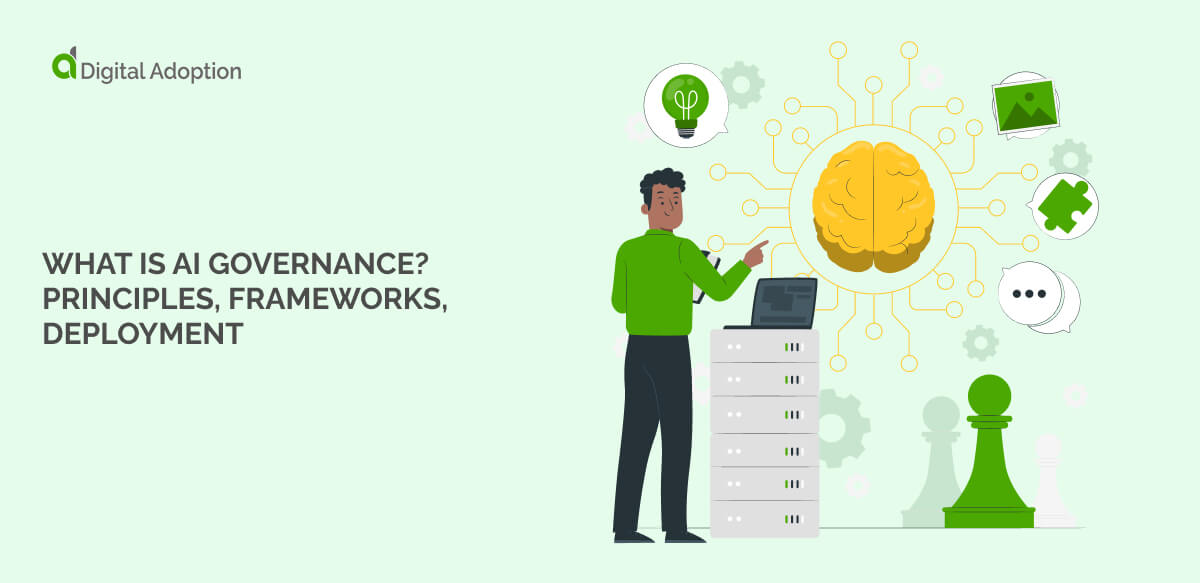Digital technology has upended the way businesses operate and engage with customers.
From AI-led automation to data management, these technologies fast-track business efficiency and help drive innovation.
AI adoption, cloud computing, and machine learning (ML) are reimagining traditional processes, with new digital products and services emerging daily.
A report by Statista revealed that the global digital transformation market is expected to reach $2.8 trillion by 2025.
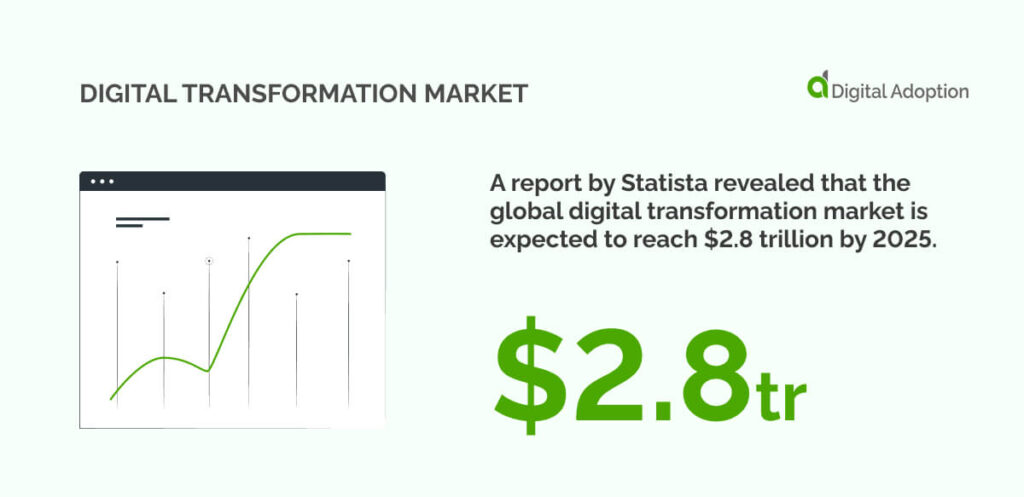
This industry-wide adoption of digital technologies is not just reshaping operations but also updating business models, changing customer experiences, and creating new value for success.
This article provides 25 digital technology examples that transformation leaders should know. Let’s get started.
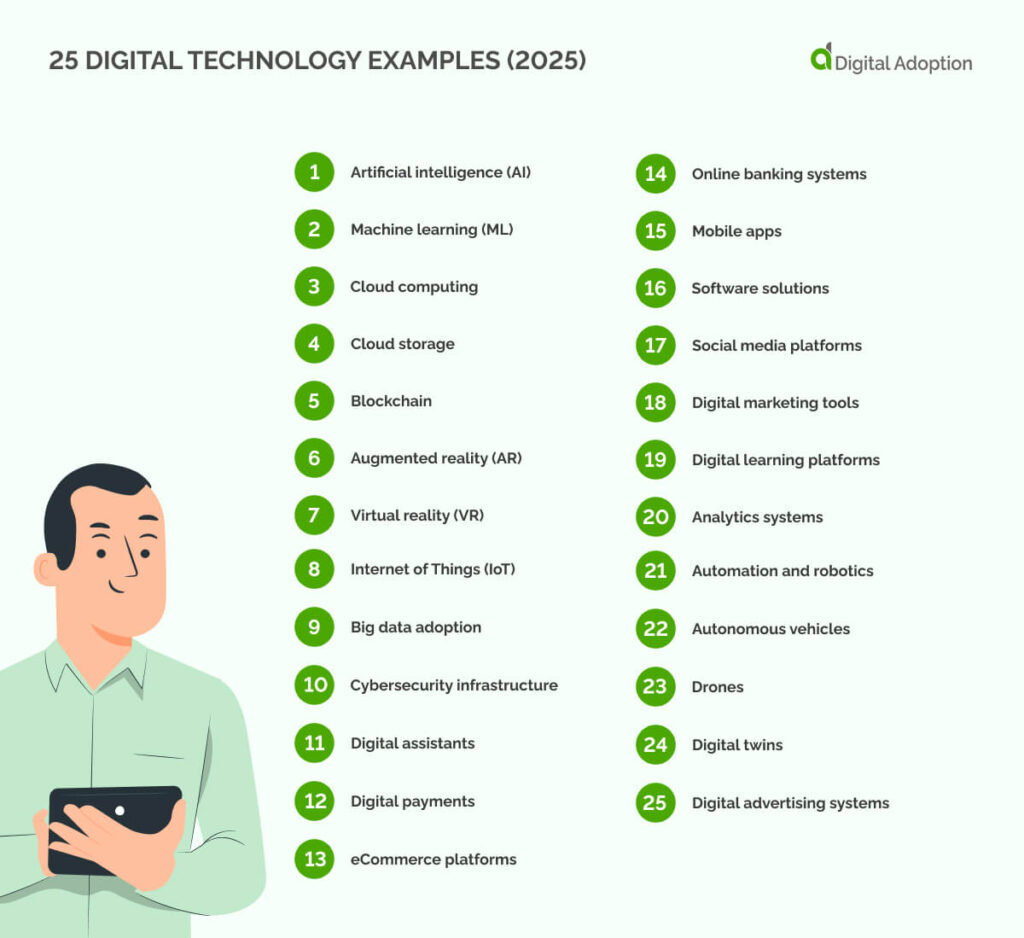
- 1. Artificial intelligence (AI)
- 2. Machine learning (ML)
- 3. Cloud computing
- 4. Cloud storage
- 5. Blockchain
- 6. Augmented reality (AR)
- 7. Virtual reality (VR)
- 8. Internet of Things (IoT)
- 9. Big data adoption
- 10. Cybersecurity infrastructure
- 11. Digital assistants
- 12. Digital payments
- 13. eCommerce platforms
- 14. Online banking systems
- 15. Mobile apps
- 16. Software solutions
- 17. Social media platforms
- 18. Digital marketing tools
- 19. Digital learning platforms
- 20. Analytics systems
- 21. Automation and robotics
- 22. Autonomous vehicles
- 23. Drones
- 24. Digital twins
- 25. Digital advertising systems
- Choosing the digital technology for your transformation needs
- People Also Ask
1. Artificial intelligence (AI)
In business, AI is used for tasks like customer service automation in eCommerce, fraud detection in FinTech, and predictive maintenance in Cybersecurity.
AI has exceeded expectations, especially in sectors like finance, by improving business speed through risk management and automatic transactions. As per McKinsey, AI adoption among organizations has remained around 50% for the past six years. However, in 2024, it rose to 72%.
This wide applicability has made AI a key player in the digital transformation race.
2. Machine learning (ML)
Machine learning (ML) algorithms continuously refine their understanding of patterns, enabling enterprise software to adapt without explicit programming.
For example, IT security platforms detect anomalies in network traffic, identifying zero-day vulnerabilities before exploitation. Cloud orchestration tools use ML to optimize resource allocation, reducing latency in distributed environments. Large-scale search engines use ML to refine ranking algorithms, ensuring the most relevant results based on user behavior.
Even software developers benefit from AI-assisted coding tools, which can now predict errors and auto-generate code. Future innovations will push ML further into AI-powered debugging, self-healing infrastructure, and automated software performance tuning.
3. Cloud computing
Cloud computing provides on-demand access to computing resources via the Internet. Enterprises no longer need extensive physical infrastructure to manage IT services. Developers use the cloud to host applications, allowing rapid updates and scalability.
For example, instead of investing in hardware, IT departments can deploy solutions across a distributed cloud network, adjusting resources in real time as demand shifts.
Future developments will focus on making cloud transformation more resilient, offering businesses secure and flexible environments for everything from application hosting to data storage while reducing overhead costs.
4. Cloud storage
Unlike cloud software, the next digital technology example is cloud storage, which allows businesses to store their data assets remotely.
IT teams use it to keep software repositories accessible from anywhere, simplifying collaboration. Files are no longer limited by physical storage space or on-premises hardware, allowing enterprise systems to scale without commitment.
With cloud storage, businesses avoid the risk of data loss from local server failures, as data is replicated across multiple locations. In addition, automatic backups keep everything up to date, preventing disruptions.
5. Blockchain
Blockchain is a water-tight method of record-keeping, recording transactions on a decentralized ledger across multiple touchpoints.
It offers secure and verifiable data management, utilizing software developers to track changes and prevent unauthorized alterations. For enterprises, blockchain can reduce administrative overhead, especially in contract verification and compliance areas.
As adoption grows, broader integration into enterprise IT systems may occur. This would help improve transparency and reduce reliance on centralized authorities.
6. Augmented reality (AR)
Augmented reality (AR) overlays digital elements using devices like smartphones or AR glasses in physical spaces. For software developers, AR can enhance user experiences by overlaying useful information on the physical world.
Developers can visualize a mobile app’s appearance in a user’s environment before deployment. It can also aid factory workers in industrial settings by providing interactive troubleshooting guides or training tools.
Looking ahead, businesses can use AR to create immersive experiences, such as virtual meetings or AI-augmented workforce, where employees can collaborate in shared virtual spaces or receive real-time guidance and data overlays to improve productivity and decision-making.
According to Statista, global revenue in the AR Software segment is expected to rise by $5 billion between 2024 and 2029, reaching a peak of $17.98 billion by 2029.
7. Virtual reality (VR)
Much like AR, virtual reality (VR) is another digital technology causing an equal amount of buzz. VR immerses users in a fully simulated environment separate from the physical world.
Developers use VR to test applications that require interaction in a 3D space, such as Metaverse worlds. IT teams also use VR to train staff in high-risk scenarios, like cybersecurity or system recovery. This helps prepare teams to handle intensive situations without actual consequences.
With VR, companies will soon offer virtual tours, immersive product demos, and remote training programs. As VR technology becomes more sophisticated, businesses will rely on it for entertainment and effective, realistic simulations that train and engage employees experimentally.
8. Internet of Things (IoT)
The Internet of Things (IoT) connects everyday devices, such as sensors, cameras, and home appliances, to the Internet.
These devices collect and share data with other systems, making monitoring and controlling them easier. IT teams use IoT for real-time system monitoring. For example, a smart thermostat can automatically adjust room temperature based on occupancy.
Developers build apps that allow businesses to track and control their devices remotely. In the future, IoT will enable businesses to make decisions based on data collected from these devices. This will unveil new levels of efficiency, reduce waste, and respond faster to previously undetectable changes.
9. Big data adoption
The next digital technology example is big data. The dominant form of currency in the Information Age, big data involves aggregating information from different sources to glean more enriching insights.
It allows businesses to analyze user behavior, website traffic, and system performance on a massive scale. Software developers rely on big data tools to improve their applications and make them more efficient. For example, companies can fine-tune their apps by analyzing user interactions to offer better features.
With better analysis techniques, big data will continue to be essential for businesses to track performance, predict trends, and optimize their operations.
10. Cybersecurity infrastructure
Cybersecurity infrastructure describes a suite of digital technology designed to protect networks, data, and devices from cyber threats.
Firewalls, encryption, and intrusion detection systems, for example, prevent unauthorized entry to business systems. Cybersecurity engineers will create software alongside cybersecurity infrastructure to block malicious attacks and safeguard personal data. IT teams watch systems closely to identify potential vulnerabilities and counteract them quickly.
Luckily, as digital technology advances, cybersecurity infrastructure will become even more proactive, using AI and ML to detect and respond to threats before they cause material damage.
11. Digital assistants
Digital assistants are software systems or virtual agents designed to assist with scheduling, reminders, and information management.
They interact with users using voice recognition and natural language processing to interact with users (NLP). Developers will use digital assistants to test software by automating routine actions like checking server status or managing code updates. Teams may rely on digital assistants for customer support tickets or system troubleshooting.
Digital assistants will become smarter as the tech underlying it evolves. They’ll be able to handle more complex tasks, such as managing entire digital workflows and analyzing business data. With AI, assistants can automatically fulfill errands and even make decisions based on your past interactions.
12. Digital payments
Digital payments are financial transactions carried out online or through mobile devices. Consumers can use services like PayPal or mobile banking apps to pay for goods and services.
Developers build secure payment systems to protect personal and financial data. IT teams ensure that digital payment platforms operate as intended and that transactions are completed without error.
Businesses will continue to adopt new methods to simplify transactions as digital payments become more widespread. This will create more payment options and make the checkout process easier and faster for users.
13. eCommerce platforms
eCommerce platforms allow businesses to sell products or services online. These platforms include features like product catalogs, payment processing, and shipping integration.
Shopify and Etsy help entrepreneurs set up stores by processing payments, managing inventory, and shipping. These platforms integrate data analysis, suggesting products based on browsing history, which improves customer experience.
As online shopping grows, e-commerce platforms will introduce even more advanced features, such as AI-driven product recommendations and faster, more personalized shopping experiences for customers.
14. Online banking systems
Online banking systems allow individuals and businesses to manage their finances online. These systems enable users to transfer funds, view secure websites and apps, and pay bills.
Banks offer secure websites and apps for bill payments, fund transfers, and account monitoring. Customers can instantly transfer money between accounts or set up automatic bill payments.
In time, online banking systems will incorporate more advanced features, such as automated savings tools and AI-driven financial advice, giving users even more control over their finances from the comfort of their devices.
15. Mobile apps
Mobile apps are software applications designed for smartphones and tablets. These apps can do anything from managing tasks to providing entertainment. With mobile apps, businesses can reach customers wherever they are, offering services just a tap away.
Examples include fitness apps that track workouts or mobile banking apps that let customers manage their finances. These apps utilize push notifications to engage users and update them in real time.
As mobile technology evolves, businesses can integrate more advanced features, such as augmented reality or AI, to offer personalized user experiences.
16. Software solutions
Software solutions are programs, apps, or platforms designed to solve specific problems or improve certain business processes.
These include project management tools like Trello or Asana, which help teams track tasks and collaborate. These technologies are integrated with other platforms, such as email and calendar apps, to unify workflows.
Over time, software solutions will become more customizable, allowing businesses to adjust them to their exact needs. This will increase their value by offering flexible, adaptable tools that scale with growth.
17. Social media platforms
Today, businesses that don’t use social media to connect with customers and promote their brand might as well remove products from the market. These platforms offer tools for posting content, interacting with users, and tracking interest.
Facebook and Twitter help brands connect with customers through posts, ads, and customer service. The future of social media lies in further personalization, with AI driving content recommendations and ads that align closely with user interests.
Expect deeper integration of shopping features, allowing users to purchase directly from platforms without leaving the app.
18. Digital marketing tools
Digital marketing tools help businesses reach customers online through ads, emails, and social media campaigns. Companies use these tools to track the success of their marketing efforts, target specific audiences, and automate routine tasks.
Google Ads and Facebook Ads Manager allow companies to target specific demographics based on behavior and location. In the future, these tools will incorporate more AI-driven marketing automation, refining ad targets based on user interaction.
19. Digital learning platforms
Digital learning platforms provide online education, offering courses and materials that can be accessed remotely. These platforms allow businesses to train employees and offer skill-building resources to customers.
Services like Coursera and Udemy offer courses on various topics, from coding to business skills. In the coming years, digital learning platforms will integrate more adaptive learning technologies that adjust content based on a learner’s progress, allowing for a more customized learning experience and skill improvement exercises.
20. Analytics systems
Analytics systems help businesses gather and analyze data to improve their processes. These systems track metrics like website traffic, sales, and customer behavior to provide insights.
Tools like Google Analytics monitor website traffic, helping businesses optimize content and sales strategies.
As data volumes increase, more predictive analytics systems are expected to emerge. These systems will offer businesses real-time insights that inform decision-making and provide a more bespoke user experience.
21. Automation and robotics
Automation and robotics refer to machines and software that complete tasks without human intervention. Robots move items from shelves in warehouses, while software automates data entry.
As capabilities grow, robots will take on more decision-making tasks. This will improve productivity in sectors like logistics, AI in manufacturing, and even customer service.
Future automation will likely blend human oversight with robotic efficiency, creating more intelligent workflows as we move toward Industry 4.0.
22. Autonomous vehicles
Autonomous vehicles are self-driving cars that use sensors, cameras, and AI to navigate without human input. In logistics, companies like Amazon are testing drones and trucks for deliveries.
On the other hand, Tesla is pushing the envelope with its fully autonomous electric vehicles, offering features like autopilot and smart navigation. These vehicles enhance driving safety, reduce traffic congestion, and lower fuel costs.
As self-driving technology becomes more accurate and reliable, it will reshape the transportation industry. This is especially true for delivery services and shared mobility solutions. This will create a new era of efficiency and cost-effectiveness in logistics.
23. Drones
Drones are unmanned aerial vehicles that can be controlled remotely and perform tasks like capturing images or transporting goods. They are finding their place across industries and are innovative for many uses.
In construction, drones are used to survey land or inspect buildings that are too dangerous for physical surveys. For delivery, companies like UPS are testing drone packages, which could look like a futuristic cityscape from a sci-fi novel.
With improved flight times and AI, drones will increasingly be used for real-time monitoring, supply chain management, and quick deliveries, especially in urban and remote settings.
24. Digital twins
Digital twins are virtual replicas of physical objects or systems. These models are used to simulate operations and predict potential issues.
In construction, digital twins help monitor building health in real-time. As industries adopt IoT sensors, digital twins will mimic their counterparts more accurately, offering detailed simulations.
Businesses, particularly manufacturing, infrastructure, and logistics, could leverage this to optimize operations, minimize downtime, and improve maintenance schedules.
25. Digital advertising systems
Digital advertising systems leverage online platforms and data analytics to target specific audiences with tailored ads. Google Adsense and Facebook Ads use user data to create ads that match interests.
The more data is aggregated, the more effective these systems will become at personalizing ads. Future advertising will use AI to optimize campaigns automatically, maximizing return on investment while improving user experiences as they shop.
Choosing the digital technology for your transformation needs
The difficulty in so many digital technologies being available today makes it hard to choose the right one to help fast-track transformation efforts.
Businesses must start by deeply understanding their needs to make the best decision. Cloud computing can provide fast access and scalable storage if processes are slow and data lifecycle management is inefficient.
It’s also important to consider the existing technology infrastructure. Some digital solutions may require significant integration with current systems, which could incur hidden costs and delay progress.
Prioritize tools with a clear software ROI and ensure your team can adapt quickly to new tools.
Every decision should be tied to measurable outcomes and aligned with your company’s strategy, considering immediate results and future expansion needs.
People Also Ask
-
What are the advantages of digital technology?Digital technology improves operational speed, reduces human errors, and increases task accuracy. Automation allows for faster processing, while cloud storage provides easier access to data across locations. Businesses can interact with customers globally through digital platforms, opening new revenue streams and improving service delivery.
-
What are the challenges of digital technology?Managing security risks remains a concern with the growing threat of cyberattacks. Integrating new technologies into existing systems can be complex and costly. As more information is stored digitally, data privacy issues arise. Additionally, overreliance on digital tools can lead to disruptions if systems fail or are compromised.

![25 Digital Technology Examples [2025]](https://www.digital-adoption.com/wp-content/uploads/2025/02/25-Digital-Technology-Examples-2025-img.jpg)



